History
 When we look at the reasons that the United States entered World War II, we think of the Japanese attack on Pearl Harbor, and we would be correct, but there was another dictator who committed so many atrocities during and before World War II, that it seems to me inevitable that we would have had to make that decision sooner or later. Adolf Hitler was a German politician, the leader of the Nazi Party, elected Chancellor of Germany from 1933 to 1945, and Führer, or leader of Nazi Germany from 1934 to 1945. One of his worst acts as Führer of Nazi Germany, was when he initiated World War II in Europe with the invasion of Poland in September 1939 and the worst act was, of course, the Holocaust.
When we look at the reasons that the United States entered World War II, we think of the Japanese attack on Pearl Harbor, and we would be correct, but there was another dictator who committed so many atrocities during and before World War II, that it seems to me inevitable that we would have had to make that decision sooner or later. Adolf Hitler was a German politician, the leader of the Nazi Party, elected Chancellor of Germany from 1933 to 1945, and Führer, or leader of Nazi Germany from 1934 to 1945. One of his worst acts as Führer of Nazi Germany, was when he initiated World War II in Europe with the invasion of Poland in September 1939 and the worst act was, of course, the Holocaust.
During the Holocaust, an insane Hitler, decided that the Jewish people were Untermenschen, or sub-human and socially undesirable, and determined in his heart to kill them. His first move in that direction was to begin rounding them up and placing them in prison camps. And one of the worst was Auschwitz. For a time, Hitler only placed the men in Auschwitz, but then on March 26, 1942, the first women prisoners arrived at Auschwitz.  Of course, Hitler’s intent was always to put the prisoners to death, but he decided to use them in whatever capacity he felt necessary and useful, before the time came to kill them. Since he considered the sub-human, he felt no guilt making them slaves. The prisoners were forced to work long hours, and were also used for medical experimentation. When the prisoners entered the camp, they were strip searched, male and female alike, and forced to stand naked in front of the guards during that time. It didn’t matter how cold they were. They did not count in the eyes of the Germans, because they were Untermenschen…sub-human. As a woman, I can only imagine how these first female prisoners must have felt. They were already very much aware that the Germans did not respect their race, so why would they feel differently about the fact that they were women. It would have been a very scary time. I’m sure they did not know if they would be raped and then killed, or what would happen to them. Their entry into the prison camp had already proven that they were nothing in the eyes of their captors.
Of course, Hitler’s intent was always to put the prisoners to death, but he decided to use them in whatever capacity he felt necessary and useful, before the time came to kill them. Since he considered the sub-human, he felt no guilt making them slaves. The prisoners were forced to work long hours, and were also used for medical experimentation. When the prisoners entered the camp, they were strip searched, male and female alike, and forced to stand naked in front of the guards during that time. It didn’t matter how cold they were. They did not count in the eyes of the Germans, because they were Untermenschen…sub-human. As a woman, I can only imagine how these first female prisoners must have felt. They were already very much aware that the Germans did not respect their race, so why would they feel differently about the fact that they were women. It would have been a very scary time. I’m sure they did not know if they would be raped and then killed, or what would happen to them. Their entry into the prison camp had already proven that they were nothing in the eyes of their captors.
 Between 1939 and 1945, there were many plans to try to assassinate Hitler. The most well known, Operation Valkyrie, which came from within Germany and was at least partly driven by the increasing prospect of a German defeat in the war. On July 20, 1944, Claus von Stauffenberg planted a bomb in one of Hitler’s headquarters…known as the Wolf’s Lair at Rustenburg. Hitler survived because staff officer Heinz Brandt moved the briefcase containing the bomb behind a leg of the heavy conference table. When the bomb exploded, the table deflected much of the blast. Later, Hitler ordered savage reprisals resulting in the execution of more than 4,900 people. In the end, he would take his own life, in an effort not to be taken alive. Not a bad thing if you ask me, because the world is truly well rid of him.
Between 1939 and 1945, there were many plans to try to assassinate Hitler. The most well known, Operation Valkyrie, which came from within Germany and was at least partly driven by the increasing prospect of a German defeat in the war. On July 20, 1944, Claus von Stauffenberg planted a bomb in one of Hitler’s headquarters…known as the Wolf’s Lair at Rustenburg. Hitler survived because staff officer Heinz Brandt moved the briefcase containing the bomb behind a leg of the heavy conference table. When the bomb exploded, the table deflected much of the blast. Later, Hitler ordered savage reprisals resulting in the execution of more than 4,900 people. In the end, he would take his own life, in an effort not to be taken alive. Not a bad thing if you ask me, because the world is truly well rid of him.
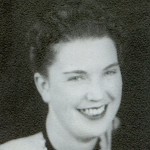 In every war, there are soldiers and there are those who serve in the background. Sometimes these people in the background have an astounding impact on the war effort. Such was the case, during World War II, when so many men were involved in the fighting, that it left very few people to work in the factories. It became obvious that the women were going to have to step up and help. Of course, it wasn’t all women either. My Uncle Bill Spencer did that work as well, because they wouldn’t take him in the service due to a hernia and flat feet. Uncle Bill, and his sisters, my aunts, Laura and Ruth Spencer, all worked at a job that would make the women famous as Rosie the Riveter. These people worked at jobs traditionally done by men, such as building bombers at Ford Motor Company’s Willow Run plant in Michigan, and the shipyards in Wisconsin, which is where my aunts and uncle worked. The work was different than work the women had done before, but they proved that they could do it. Their motto became just that…We Can Do It!!
In every war, there are soldiers and there are those who serve in the background. Sometimes these people in the background have an astounding impact on the war effort. Such was the case, during World War II, when so many men were involved in the fighting, that it left very few people to work in the factories. It became obvious that the women were going to have to step up and help. Of course, it wasn’t all women either. My Uncle Bill Spencer did that work as well, because they wouldn’t take him in the service due to a hernia and flat feet. Uncle Bill, and his sisters, my aunts, Laura and Ruth Spencer, all worked at a job that would make the women famous as Rosie the Riveter. These people worked at jobs traditionally done by men, such as building bombers at Ford Motor Company’s Willow Run plant in Michigan, and the shipyards in Wisconsin, which is where my aunts and uncle worked. The work was different than work the women had done before, but they proved that they could do it. Their motto became just that…We Can Do It!!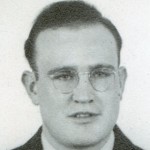
Now, seven decades later, and after several memorials in their honor, 30 of the “Rosie the Riveters” were honored with a trip to Washington DC to visit the National World War II Memorial. These women are in their 80s and 90s now, and it was a wonderful trip for them to go and see the memorial, pose for group photos with the US Capitol as a backdrop, have lunch at a Library of Congress building and visit Arlington National Cemetery. All that was awesome, but the real honor was that at every stop, people approached them, shook their hands, and said, “Thank you.” So often we overlook the opportunity to thank those who have served our country. We might feel like we are intruding, or don’t know what to say, or we just feel strange, but sometimes we need to set those feelings aside, so that we can honor all those who served…no matter in what capacity they served.
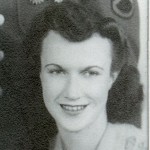 These women symbolized the American spirit that made this country great, and it is a spirit that needs to be brought back to this country. We are a great nation, with great people. When we make up our minds to do something, we get it done. The was the attitude these women took to the bomber factories and the shipyards. They decided that they could carry the load of the homefront to make the fighting men safer…and they did. I’m very proud that my Uncle Bill, and my aunts, Laura and Ruth were a part of such an elite group as these women who were honored today, I only wish they could have been a part of this trip. Both of my aunts are in Heaven now, and Uncle Bill is in a nursing home with Dementia, so they could not be there. Nevertheless, I’m very proud of all three of them…and these incredible women who were honored today.
These women symbolized the American spirit that made this country great, and it is a spirit that needs to be brought back to this country. We are a great nation, with great people. When we make up our minds to do something, we get it done. The was the attitude these women took to the bomber factories and the shipyards. They decided that they could carry the load of the homefront to make the fighting men safer…and they did. I’m very proud that my Uncle Bill, and my aunts, Laura and Ruth were a part of such an elite group as these women who were honored today, I only wish they could have been a part of this trip. Both of my aunts are in Heaven now, and Uncle Bill is in a nursing home with Dementia, so they could not be there. Nevertheless, I’m very proud of all three of them…and these incredible women who were honored today.
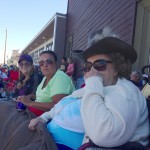 I saw an older woman standing at the bus stop today, waiting for the bus to arrive. That isn’t anything unusual, except that this woman was wearing a cowboy hat. I’m sure that many people wouldn’t think that was unusual either, given that I live in Wyoming, and in reality it was not that I thought it was unusual either, because I didn’t. What came to my mind was my mother, Collene Byer Spencer. Mom and my dad, Allen Spencer, embraced Wyoming, and the West in general, all their lives. They loved the history of the West, cowboy boots and cowboy hats, and they wore their western gear often, especially when they traveled.
I saw an older woman standing at the bus stop today, waiting for the bus to arrive. That isn’t anything unusual, except that this woman was wearing a cowboy hat. I’m sure that many people wouldn’t think that was unusual either, given that I live in Wyoming, and in reality it was not that I thought it was unusual either, because I didn’t. What came to my mind was my mother, Collene Byer Spencer. Mom and my dad, Allen Spencer, embraced Wyoming, and the West in general, all their lives. They loved the history of the West, cowboy boots and cowboy hats, and they wore their western gear often, especially when they traveled.
I know that there are lots of people who wear cowboy hats, as was proven by the older woman waiting for the bus, but what struck me at the time was that it brought back the memories of my mom wearing her cowboy hat. Mom especially loved 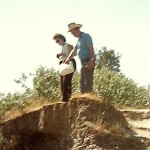 wearing her hat at the parade, as did my dad. They especially loved when the military people went by. Dad was a World War II veteran, and he was very proud of our soldiers. Mom loved it all. She would whoop and holler for every entry. I think she just didn’t want anyone to feel bad about their entry, and sometimes people would just sit there without clapping for anyone. Mom liked to make sure that everyone felt happy, parade or otherwise.
wearing her hat at the parade, as did my dad. They especially loved when the military people went by. Dad was a World War II veteran, and he was very proud of our soldiers. Mom loved it all. She would whoop and holler for every entry. I think she just didn’t want anyone to feel bad about their entry, and sometimes people would just sit there without clapping for anyone. Mom liked to make sure that everyone felt happy, parade or otherwise.
Mom and Dad had a number of cowboy hats, and the wore them all. They never went on vacation without a cowboy hat. I think they probably even took one on their 50th Anniversary cruise to Alaska. So many of my best camping memories include a cowboy hat. Dad never blew on a fire to get it going, he used his cowboy hat. Smart man, it would save a lot of work on the lungs…and the fire  always started faster for him than for us. So many cowboy hat memories.
always started faster for him than for us. So many cowboy hat memories.
As I drove past the older woman wearing the cowboy hat, I had a smile on my face, because just seeing her standing there reminded me so much of so many good times from my past. As a kid, I would never have thought of myself as a cowgirl…at that time in my life a cowgirl or country music just weren’t cool. These days I love country music, but I guess I’m still not a cowgirl. Nevertheless, my parents were, and they were proud of it. It doesn’t matter to me what they identified themselves with…I just know that I am very proud of them. And I love and miss them very much.
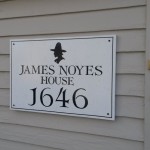
 A while back, I wrote a story about a house in Massachusetts that was built by our ancestor, James Noyes, who is my husband, Bob’s 7th great grandfather. Almost immediately, a cousin of ours, Paul Noyes told me that he had been there many times, and yet another cousin, David Noyes had been invited inside and had pictures. Of course, this was exactly what I was hoping for, because I wanted to talk about the interior of the home, but could not find any pictures online. So, I want to thank David for these beautiful pictures, and Paul for forwarding them to me, so that I can tell a little about the inside of this grand old house. My husband, Bob was sure that the interior had probably been renovated several times since the 1646 date that the house was built, but other than what has been documented, there is no indication of a massive remodel.
A while back, I wrote a story about a house in Massachusetts that was built by our ancestor, James Noyes, who is my husband, Bob’s 7th great grandfather. Almost immediately, a cousin of ours, Paul Noyes told me that he had been there many times, and yet another cousin, David Noyes had been invited inside and had pictures. Of course, this was exactly what I was hoping for, because I wanted to talk about the interior of the home, but could not find any pictures online. So, I want to thank David for these beautiful pictures, and Paul for forwarding them to me, so that I can tell a little about the inside of this grand old house. My husband, Bob was sure that the interior had probably been renovated several times since the 1646 date that the house was built, but other than what has been documented, there is no indication of a massive remodel.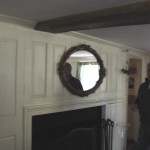

James Noyes, moved to and was co-founder of Newberry, Massachusetts in 1635, bringing with him, his wife Sarah Brown Noyes. Little was documented about where in Newbury they lived before the Noyes home was built in 1646, but the family grew by five children…Joseph, James, Sarah (who died at an unknown young age), Moses, and John. I would assume that their growing family was the reason for the large home to be built. Even with that, the home was not what we would consider large these days. The current home has five bedrooms, but it is my guess that the original probably had only three, a master bedroom for the parents, a bedroom for the boys, and a bedroom for the girls. The house was only one room deep in those years, and while it might have been somewhat small, I can only imagine what stories those walls would tell, if they could 
 talk. My guess is that there would be stories of laughter, sadness, and crying as new babies joined the family. The family grew, with the additions of Thomas, Rebecca, William, and a second daughter named Sarah, after her mother and the first Sarah, who had passed away.
talk. My guess is that there would be stories of laughter, sadness, and crying as new babies joined the family. The family grew, with the additions of Thomas, Rebecca, William, and a second daughter named Sarah, after her mother and the first Sarah, who had passed away.
James and Sarah lived in the house for the remainder of their days, during which time the house saw children come into the family, and children marry and move away, returning now and again to share their children with their parents. Then on October 22, 1656, just seven months after his second daughter named Sarah, was born, James passed away. The house saw the sadness of a family in mourning for its patriarch. Sarah became the head of the family then, and so it remained until her passing on September 13, 1691. James and Sarah were blessed with at least 47 grandchildren…not all of whom lived very long unfortunately. Not much is said about 
 what the children did with the home after their mother’s passing, but while it has been home to a number of families over the many years since it was built, it remains an important historical home and is listed on the National Registry of Historic Places. There were some changes, which added size to the home making it a five bedroom home at this present time. The last time the home was sold was in 2010, and it is my assumption that it was the current owners who allowed our cousin David Noyes to have a tour and take the pictures I now have of this beautiful home.
what the children did with the home after their mother’s passing, but while it has been home to a number of families over the many years since it was built, it remains an important historical home and is listed on the National Registry of Historic Places. There were some changes, which added size to the home making it a five bedroom home at this present time. The last time the home was sold was in 2010, and it is my assumption that it was the current owners who allowed our cousin David Noyes to have a tour and take the pictures I now have of this beautiful home.
 I think that were it not for the danger involved, I could be a storm chaser. I love to watch the shows about storm chasers and about tornadoes themselves. I suppose the main reason I like those shows is that you can watch the awesomeness of nature’s storms, but you don’t really have to deal with the reality of the loss of life and damage to property. It seems more like a scene from a movie. Nevertheless, the reality is that in a real storm situation, tornadoes kill and they damage property. The first recognized storm chaser was David Hoadley, who began chasing North Dakota storms in 1956. Hoadley used data from area weather offices and airports to calculate the possible areas for tornadic activity. Hoadley is considered the pioneer storm chaser and was the founder of Storm Track magazine. With storms such as the Tri-State Tornado which occurred on this day, March 18, 1925, and many others that followed, I’m sure that Hoadley could see that there was a need for someone to find a way to predict the path of these deadly storms.
I think that were it not for the danger involved, I could be a storm chaser. I love to watch the shows about storm chasers and about tornadoes themselves. I suppose the main reason I like those shows is that you can watch the awesomeness of nature’s storms, but you don’t really have to deal with the reality of the loss of life and damage to property. It seems more like a scene from a movie. Nevertheless, the reality is that in a real storm situation, tornadoes kill and they damage property. The first recognized storm chaser was David Hoadley, who began chasing North Dakota storms in 1956. Hoadley used data from area weather offices and airports to calculate the possible areas for tornadic activity. Hoadley is considered the pioneer storm chaser and was the founder of Storm Track magazine. With storms such as the Tri-State Tornado which occurred on this day, March 18, 1925, and many others that followed, I’m sure that Hoadley could see that there was a need for someone to find a way to predict the path of these deadly storms.
The March 18, 1925 tornado traveled across the tri-state area of eastern Missouri, southern Illinois, and southern Indiana, killing 695 people, injuring some 13,000 people, and causing $17 million in property damage. It became known as the Tri-State Tornado, and it shocked the nation. The tornado first touched down in Ellington, Missouri at about 1:00pm, but the worst hit area was southern Illinois. More than 500 of the 695 people lost dies in Illinois, including 234 in the city of Murphysboro and 127 in West Frankfort.
In all, the Tri-State Tornado traveled 219 miles in it’s path of destruction, and was on the ground more than three hours. It ripped through 164 square miles and was more than a mile wide. It traveled at speeds of more than 70 miles per hour. There has never been a worse tornado in the history of the United States. Years after the Tri-State Tornado, scientists discovered the cyclic nature of tornado-producing thunderstorms. These 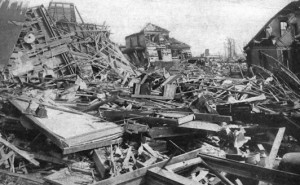 storms are able to produce one tornado after another, in a seemingly continuous damage path, that could easily be mistaken for a single tornado, when they were actually a family of tornadoes. Of course, with all the time that had passed, and the lack of things like Doppler Radar to see what the storm really was, it is nearly impossible to determine 91 years later whether or not the Tri-State tornado was one or a family of tornadoes, it remains in the history books as the longest-tracked and deadliest single tornado in recorded history. I have to wonder if David Hoadley, or someone like him had been able to predict these storms, maybe the loss of life would have been much lower.
storms are able to produce one tornado after another, in a seemingly continuous damage path, that could easily be mistaken for a single tornado, when they were actually a family of tornadoes. Of course, with all the time that had passed, and the lack of things like Doppler Radar to see what the storm really was, it is nearly impossible to determine 91 years later whether or not the Tri-State tornado was one or a family of tornadoes, it remains in the history books as the longest-tracked and deadliest single tornado in recorded history. I have to wonder if David Hoadley, or someone like him had been able to predict these storms, maybe the loss of life would have been much lower.
 Once a year, on March 17th, the world takes a day to celebrate the wearin’ o’ the green. Saint Patrick’s Day, is really just one of the more fun holidays, that for most of us means nothing more than pinching ayone caught not wearing green, eating corned beef and cabbage, or drinking green beer and celebrating with our friends.
Once a year, on March 17th, the world takes a day to celebrate the wearin’ o’ the green. Saint Patrick’s Day, is really just one of the more fun holidays, that for most of us means nothing more than pinching ayone caught not wearing green, eating corned beef and cabbage, or drinking green beer and celebrating with our friends.
If we lived in Ireland, the day would be very different. That is because in Ireland, Saint Patrick’s Day is a day to celebrate Saint Patrick, who was the patron saint of Ireland. Saint Patrick lived in Ireland in the late fourth and early fifth centuries, but he wasn’t Irish. He was was a Romano-Briton who was captured by Irish raiders and taken to 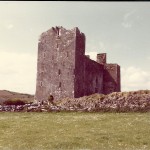 Ireland as a slave. Saint Patrick was the kind of man who, made lemonaid out of the lemons he found himself with. While he was enslaved in Ireland, he made it his goal to become a missionary there, and he is credited with bringing Christianity to the country, as a result. In Ireland, that makes the holiday a religious holiday, similar to Christmas and Easter. These days you can find Saint Patrick’s Day parades, shamrocks, and green Guinness beer in Ireland, but it’s mostly there for the tourists who think that is the right way to celebrate the day. For most of the Irish, however it would not be that way, and in fact, up until 1970 Irish laws mandated that pubs be closed on Saint Patrick’s Day. That is a stark contrast to the way the day is celebrated here, but it doesn’t mean the same thing to Americans.
Ireland as a slave. Saint Patrick was the kind of man who, made lemonaid out of the lemons he found himself with. While he was enslaved in Ireland, he made it his goal to become a missionary there, and he is credited with bringing Christianity to the country, as a result. In Ireland, that makes the holiday a religious holiday, similar to Christmas and Easter. These days you can find Saint Patrick’s Day parades, shamrocks, and green Guinness beer in Ireland, but it’s mostly there for the tourists who think that is the right way to celebrate the day. For most of the Irish, however it would not be that way, and in fact, up until 1970 Irish laws mandated that pubs be closed on Saint Patrick’s Day. That is a stark contrast to the way the day is celebrated here, but it doesn’t mean the same thing to Americans.
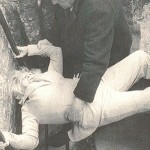
Like many people, I like to eat corned beef and cabbage and pinch those unsuspecting people who have forgotten their green, and while I don’t drink beer…green or otherwise, I like to have fun with the day. But, I also like to reflect a little bit on my Irish roots. I have several parts of my family who came from Ireland, including my Grandma Byer’s family. She wanted to get in touch with her Irish roots too, and so she and her siblings took a trip back to the old country, where they saw the castles, and cemeteries, kissed the Blarney Stone, and visited all the other sites, and I believe they met some of the family who still lives there too. It wasn’t Saint Patrick’s Day when she went, but they really had a good time.
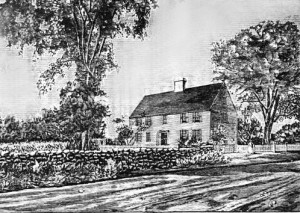 As an insurance agent and living in Wyoming, which does not have the history that some of my ancestors built in the east, when I think of an old house, something in the 1910s comes to mind, but in reality, that is not an old house at all. In fact, by comparison to Bob’s 7th great grandfather, Reverend James Noyes’ house, a home built in 1910 would be considered brand new. The house James Noyes built was, and still is located at 7 Parker Street in Newberry, Massachusetts…a small town of about 7,000 people located in Essex County. It is really a suburb of Newburyport, which has a population of about 18,000. Newbury is situated in the Northeast corner of Massachusetts, near the coast. Newbury was founded by Reverend James Noyes and his cousin Reverend Thomas Parker, who were English clergymen who immigrated to the United States. James Noyes was educated at Oxford, before relocating to Massachusetts in 1634. He spent a short time in Medford, before moving to Newbury to pastor a church there from 1635 until his death. He sailed aboard the Mary and John of London, accompanied by the Hercules on March 23, 1634 with his wife Sarah Noyes, brother Reverend Nicholas Noyes and cousin Reverend Thomas Parker. Newbury was originally named Newbury Plantation, and was incorporated in 1635.
As an insurance agent and living in Wyoming, which does not have the history that some of my ancestors built in the east, when I think of an old house, something in the 1910s comes to mind, but in reality, that is not an old house at all. In fact, by comparison to Bob’s 7th great grandfather, Reverend James Noyes’ house, a home built in 1910 would be considered brand new. The house James Noyes built was, and still is located at 7 Parker Street in Newberry, Massachusetts…a small town of about 7,000 people located in Essex County. It is really a suburb of Newburyport, which has a population of about 18,000. Newbury is situated in the Northeast corner of Massachusetts, near the coast. Newbury was founded by Reverend James Noyes and his cousin Reverend Thomas Parker, who were English clergymen who immigrated to the United States. James Noyes was educated at Oxford, before relocating to Massachusetts in 1634. He spent a short time in Medford, before moving to Newbury to pastor a church there from 1635 until his death. He sailed aboard the Mary and John of London, accompanied by the Hercules on March 23, 1634 with his wife Sarah Noyes, brother Reverend Nicholas Noyes and cousin Reverend Thomas Parker. Newbury was originally named Newbury Plantation, and was incorporated in 1635.

The house that Reverend James Noyes built in 1646, is a historic First Period house, and was added to the National Historic Register of Historic Places in 1990. First Period houses have a steeply pitched roof, a slightly asymmetrical plan, and a central chimney. The first period house is distinguished from later houses by its exposed…often decorated or beveled frame in the interior. Some early windows in modest houses may have had no glazing, but the standard first period window, until at least 1700, was the diamond-paned casement. The main block of the James Noyes house is a 2½ story wood frame structure, five bays wide, with a large central chimney. When the house was first built, it was only a single room deep. Then, around 1800 a 2½ story cross gabled addition was added to the rear, which was further extended by a 1½ story addition later in the 19th century. The interior rooms of the main block have Federal period styling, probably dating to the time of the first addition.
I’m sure that to many people the idea of a house built in 1646 that is still standing is, at best a novelty, but when you couple that with the fact that it was built by one of your ancestors, it becomes a little bit more interesting. My mind wanders back to what life might have been like for them in that home in the mid 1600s.  Of course, there were no modern amenities, such as a bathroom, dishwasher, refrigerator, modern stove, and other such conveniences, but it was still a pretty house for the era, I’m sure. While it was originally quite a bit smaller, but with the additions, it is now 4200 square feet and has six bedrooms. I have looked around online to see if there are any pictures of the interior of the home, but found none to date. Maybe we will have to visit there sometime, but until then, I will just have to be happy knowing that a home built by our ancestor, and a founder of Newbury, Massachusetts is still stand, still in good condition, and still being occupied by a family, who is making memories of their own there.
Of course, there were no modern amenities, such as a bathroom, dishwasher, refrigerator, modern stove, and other such conveniences, but it was still a pretty house for the era, I’m sure. While it was originally quite a bit smaller, but with the additions, it is now 4200 square feet and has six bedrooms. I have looked around online to see if there are any pictures of the interior of the home, but found none to date. Maybe we will have to visit there sometime, but until then, I will just have to be happy knowing that a home built by our ancestor, and a founder of Newbury, Massachusetts is still stand, still in good condition, and still being occupied by a family, who is making memories of their own there.
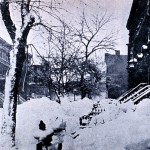 As we sit here, with an early Spring upon us, I find it an odd thing to think about another year that had been rather balmy too. The year was 1888, and things were about to get serious along the northern East Coast. The day began with rain, but as the storm really came at around midnight, the rain turned to snow, and the area began to become a nightmare right before the very eyes of the people in the area. Snowfalls of between 20 to 60 inches were seen in parts of New Jersey, New York, Massachusetts, and Connecticut. The winds howled…sustained winds of more than 45 miles per hour producing snowdrifts in excess of 50 feet. The area railroads were shut down and people were confined to their houses for up to a week. The difficult thing here is that people didn’t have some of the weather predictors that we have these days, so many of them had no idea what was coming their way, and so had far k=less time to prepare for it.
As we sit here, with an early Spring upon us, I find it an odd thing to think about another year that had been rather balmy too. The year was 1888, and things were about to get serious along the northern East Coast. The day began with rain, but as the storm really came at around midnight, the rain turned to snow, and the area began to become a nightmare right before the very eyes of the people in the area. Snowfalls of between 20 to 60 inches were seen in parts of New Jersey, New York, Massachusetts, and Connecticut. The winds howled…sustained winds of more than 45 miles per hour producing snowdrifts in excess of 50 feet. The area railroads were shut down and people were confined to their houses for up to a week. The difficult thing here is that people didn’t have some of the weather predictors that we have these days, so many of them had no idea what was coming their way, and so had far k=less time to prepare for it.
Areas of northern Vermont received from 20 inches to 30 inches in this storm, with drifts reported from 30 to 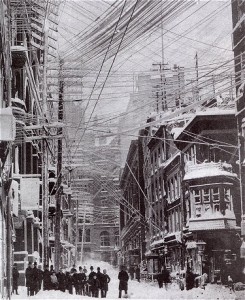 40 feet over the tops of houses from New York to New England. There were also reports of drifts covering 3 story houses. The highest drift…52 feet was recorded in Gravesend, New York. A total of 58 inches of snow fell in Saratoga Springs, New York; 48 inches in Albany, New York; 45 inches of snow in New Haven, Connecticut; and 22 inches of snow in New York City. With the snow came severe winds, with gusts up to 80 miles per hour, although the highest official report in New York City was 40 miles per hour, with a 54 miles per hour gust reported at Block Island. Central Park Observatory, in New York City, reported a low temperature of 6 °F, and a high temperature of 9 °F on March 13…the coldest ever for March. These days Winter Storms have names, but they didn’t then. Nevertheless, the storm was named the Great White Hurricane. It paralyzed the East Coast from the Chesapeake Bay to Maine, as well as the Atlantic provinces of Canada. The Telegraph was disabled because of all the downed lines, isolating Montreal and most of the large northeastern United States cities from Washington DC to Boston for days. Following the storm, New York began placing its telegraph and telephone lines underground to prevent destruction. From Chesapeake Bay through the New England area, more than 200 ships were either grounded or wrecked, killing at least 100 seamen.
40 feet over the tops of houses from New York to New England. There were also reports of drifts covering 3 story houses. The highest drift…52 feet was recorded in Gravesend, New York. A total of 58 inches of snow fell in Saratoga Springs, New York; 48 inches in Albany, New York; 45 inches of snow in New Haven, Connecticut; and 22 inches of snow in New York City. With the snow came severe winds, with gusts up to 80 miles per hour, although the highest official report in New York City was 40 miles per hour, with a 54 miles per hour gust reported at Block Island. Central Park Observatory, in New York City, reported a low temperature of 6 °F, and a high temperature of 9 °F on March 13…the coldest ever for March. These days Winter Storms have names, but they didn’t then. Nevertheless, the storm was named the Great White Hurricane. It paralyzed the East Coast from the Chesapeake Bay to Maine, as well as the Atlantic provinces of Canada. The Telegraph was disabled because of all the downed lines, isolating Montreal and most of the large northeastern United States cities from Washington DC to Boston for days. Following the storm, New York began placing its telegraph and telephone lines underground to prevent destruction. From Chesapeake Bay through the New England area, more than 200 ships were either grounded or wrecked, killing at least 100 seamen.
In New York, all transportation was at a standstill for days, and drifts across the New York–New Haven rail line at Westport, Connecticut took eight days to clear. Partly because of the transportation gridlock, it was decided that they needed a better system, and the first underground subway system in the United States, opened nine years later in 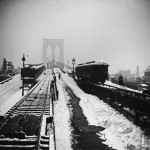 Boston. The New York Stock Exchange was closed for two days…something that almost never happens. Firefighters were unable to get to the fires, and property loss just from the fires was estimated at $25 million. Severe flooding occurred after the storm due to melting snow, especially in the Brooklyn area, which was more susceptible to serious flooding. Efforts were made to push the snow into the Atlantic Ocean. More than 400 people died from the storm and the cold that came with it, including 200 in New York City alone. Among them was former United States Senator Roscoe Conkling. The blizzard also resulted in the founding of the Christman Bird and Wildlife Sanctuary located near Delanson, Schenectady County, New York, which was listed on the National Register of Historic Places in 1970.
Boston. The New York Stock Exchange was closed for two days…something that almost never happens. Firefighters were unable to get to the fires, and property loss just from the fires was estimated at $25 million. Severe flooding occurred after the storm due to melting snow, especially in the Brooklyn area, which was more susceptible to serious flooding. Efforts were made to push the snow into the Atlantic Ocean. More than 400 people died from the storm and the cold that came with it, including 200 in New York City alone. Among them was former United States Senator Roscoe Conkling. The blizzard also resulted in the founding of the Christman Bird and Wildlife Sanctuary located near Delanson, Schenectady County, New York, which was listed on the National Register of Historic Places in 1970.
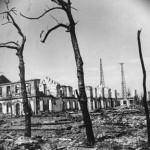 Anytime humans go to war, the one sure outcome is loss of life. That is just a fact of war. Of all the wars that the United States has been involved in, World War II interests me the most, because of my dad’s involvement, I’m sure. War is a brutal activity, but with the evil in the world, it is sometimes necessary. Evil nations leave us no choice but to step in. Such was that case with World War II, and Japan. On this day, March 9, 1945, the United States warplanes launched a new offensive against Japan. The campaign carried out involved dropping 2,000 tons of incendiary bombs on Tokyo over a two day period. Almost 16 square miles in and around the city were incinerated, and between 80,000 and 130,000 Japanese civilians were killed in the worst firestorm in recorded history.
Anytime humans go to war, the one sure outcome is loss of life. That is just a fact of war. Of all the wars that the United States has been involved in, World War II interests me the most, because of my dad’s involvement, I’m sure. War is a brutal activity, but with the evil in the world, it is sometimes necessary. Evil nations leave us no choice but to step in. Such was that case with World War II, and Japan. On this day, March 9, 1945, the United States warplanes launched a new offensive against Japan. The campaign carried out involved dropping 2,000 tons of incendiary bombs on Tokyo over a two day period. Almost 16 square miles in and around the city were incinerated, and between 80,000 and 130,000 Japanese civilians were killed in the worst firestorm in recorded history.
Early that morning, Air Force crews met on the Mariana Islands of Tinian and Saipan for a briefing. This would be a low level bombing attack on Tokyo beginning in the evening, but this one would be different. The planes would be stripped of all guns except for the tail turret. This would decrease the weight…increasing the speed of  each Superfortress bomber. This also increased the bomb load capacity by 65 percent. Now each plane could carry more than seven tons of bombs. The most crucial thing, however, would be speed. If the plane didn’t make it out of the city, the airmen were warned to get to the water as fast as they could, because their very lives depended on it. Staying in the city would mean a fiery death, because they were going to be delivering the biggest firecracker the Japanese have ever seen.
each Superfortress bomber. This also increased the bomb load capacity by 65 percent. Now each plane could carry more than seven tons of bombs. The most crucial thing, however, would be speed. If the plane didn’t make it out of the city, the airmen were warned to get to the water as fast as they could, because their very lives depended on it. Staying in the city would mean a fiery death, because they were going to be delivering the biggest firecracker the Japanese have ever seen.
The first location would be the suburb of Shitamachi, which was composed of roughly 750,000 people. The destruction of Shitamachi would destroy the light industries, called “shadow factories,” that produced prefabricated war materials for Japanese aircraft factories. The citizens of Shitamachi never had a chance against the Superfortress B-29 bombers. Their fire brigades were undermanned, poorly trained, and ill equipped. All the people could do was to run from the inferno that the city had become. The planes…334 in all, came in a just 500 feet above the ground. Most of them didn’t make it. Doctors said, “The human carnage  was so great that the blood-red mists and stench of burning flesh that wafted up sickened the bomber pilots, forcing them to grab oxygen masks to keep from vomiting.”
was so great that the blood-red mists and stench of burning flesh that wafted up sickened the bomber pilots, forcing them to grab oxygen masks to keep from vomiting.”
The entire raid lasted just a little longer than three hours. When it was over the Sumida River was clogged with bodies of the dead, burned beyond recognition. The sight was beyond anything anyone could have imagined. The loss of American lives was a mere 243 airmen, and these were considered to be acceptable losses. I suppose that these days, such a raid on known civilian targets would be considered unacceptable, but at the time it was considered acceptable, and even necessary. And it was successful, in a horrible sort of way.
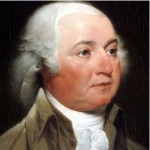 Before women could vote, the first lady in our White House was primarily there to handle the household staff, entertainment, and just look pretty beside her husband…the President. Of course, this was during the age when it was thought that women simply couldn’t handle the serious political information that it took to run a country. These days, women would howl in protest at the thought of being placed in the pretty, but incapable box. In reality, the women back then didn’t like it much either, but it seemed that there was nothing they could do about it…at least, not at the time. Still, even though women were not allowed to vote or have a political voice, there were men who valued the opinions and insights of their wives. One of those men was President John Adams. I suppose that Abigail Adams could have had one of those amazing minds, and that would seem to be the case from the different topics of discussion between John Adams and his wife, but the sequence of events that took place on this day March 7, 1777, is nothing short of amazing.
Before women could vote, the first lady in our White House was primarily there to handle the household staff, entertainment, and just look pretty beside her husband…the President. Of course, this was during the age when it was thought that women simply couldn’t handle the serious political information that it took to run a country. These days, women would howl in protest at the thought of being placed in the pretty, but incapable box. In reality, the women back then didn’t like it much either, but it seemed that there was nothing they could do about it…at least, not at the time. Still, even though women were not allowed to vote or have a political voice, there were men who valued the opinions and insights of their wives. One of those men was President John Adams. I suppose that Abigail Adams could have had one of those amazing minds, and that would seem to be the case from the different topics of discussion between John Adams and his wife, but the sequence of events that took place on this day March 7, 1777, is nothing short of amazing.
While John, who was at the time, a Continental Congressman, was in Philadelphia with the Continental Congress, and Abigail was in Braintree, Massachusetts at the family farm, he wrote her three letters, and received two letters that she had written in February. The correspondence between the two, was quite remarkable, and in all numbered 1,160 letters. They covered topics ranging from politics to military strategy, and from household economy to family health. John could see the value of his wife’s mind in all his life’s work, but probably the most in his presidency…other than family, that is. In many ways, it is sad to think that the minds of so many amazing women have gone untapped when it comes to the political arena. Of course, not all minds, male or female, intelligent or not so intelligent, can be said to have a good grasp of the important things necessary to run a nation, and keep it from derailing…as we have seen in recent years. Our nation needs people who understand how a Constitutional Republic works…and sadly, many don’t. But John Adams knew how important our Constitution was and always would be…as did his wife, Abigail. John was probably on the forefront of modern thought, in that he saw in his wife the ability to think politically, militarily, economically, as well as all of the thoughts any wife and mother has for her family. John and Abigail were not alone either. They were among the few people of that time, who saw women as intellectual and emotional equals.
In his letter, John mentioned that he felt saddened by the move of the capital to Baltimore, saying “This City is a dull Place, in Comparason [sic] of what it was. More than one half the Inhabitants have removed to the Country, as it was their Wisdom to do—the Remainder are chiefly Quakers as dull as Beetles. From these neither good is to be expected nor Evil to be apprehended. They are a kind of neutral Tribe, or the Race of the insipids. By contrast, Adams described the Loyalists, who prepared their Minds and Bodies, Houses and Cellars,  to receive General William Howe should he attack, as a Pack of sordid Scoundrels male and female.” Abigail had written the letters he received on this day, in February, in which she spoke of the difficulty of corresponding during war, but also spoke of the lack of military fervor demonstrated by the New Englanders around her. I’m sure there was a weariness among the people. She wrote that she awaited greater patriotism, greater prosperity and future correspondence from her beloved husband to his devoted Portia, a nickname John had give her likely in reference to the intelligent and devoted heroine of Shakespeare’s Portia in The Merchant of Venice. These words and the respect her husband had for his wife and her mind were very unusual in a time when women were placed in the pretty, but incapable box.
to receive General William Howe should he attack, as a Pack of sordid Scoundrels male and female.” Abigail had written the letters he received on this day, in February, in which she spoke of the difficulty of corresponding during war, but also spoke of the lack of military fervor demonstrated by the New Englanders around her. I’m sure there was a weariness among the people. She wrote that she awaited greater patriotism, greater prosperity and future correspondence from her beloved husband to his devoted Portia, a nickname John had give her likely in reference to the intelligent and devoted heroine of Shakespeare’s Portia in The Merchant of Venice. These words and the respect her husband had for his wife and her mind were very unusual in a time when women were placed in the pretty, but incapable box.

